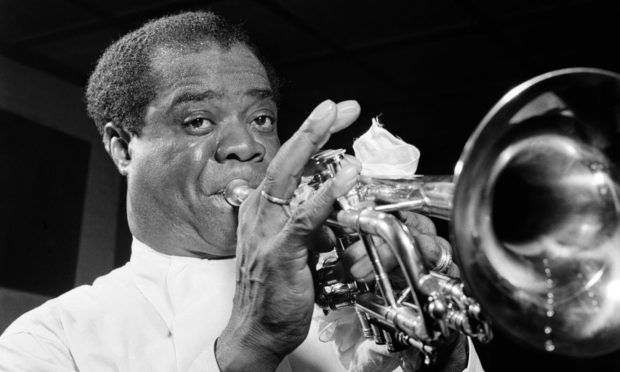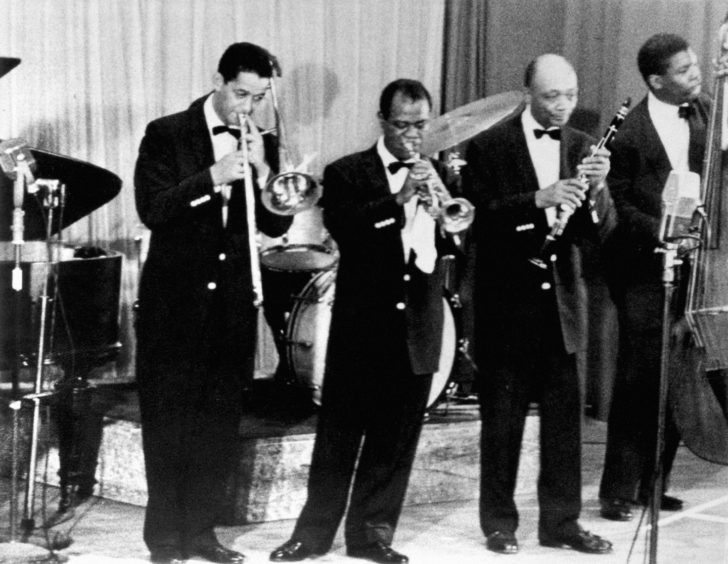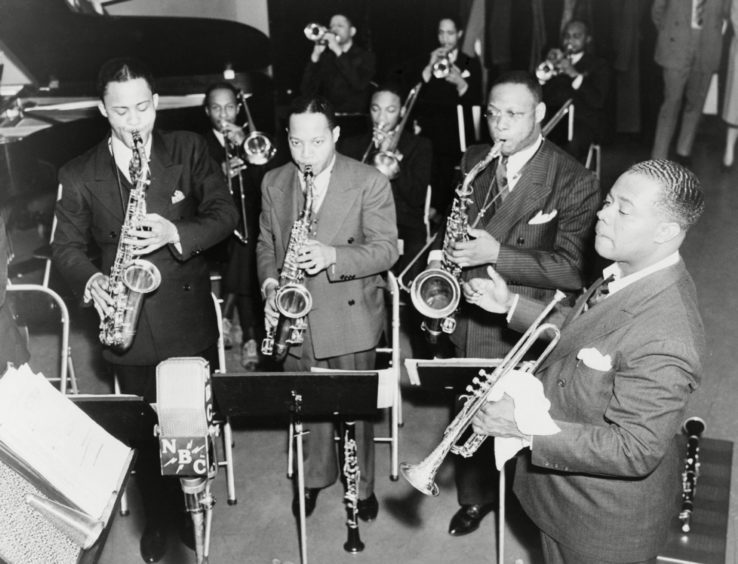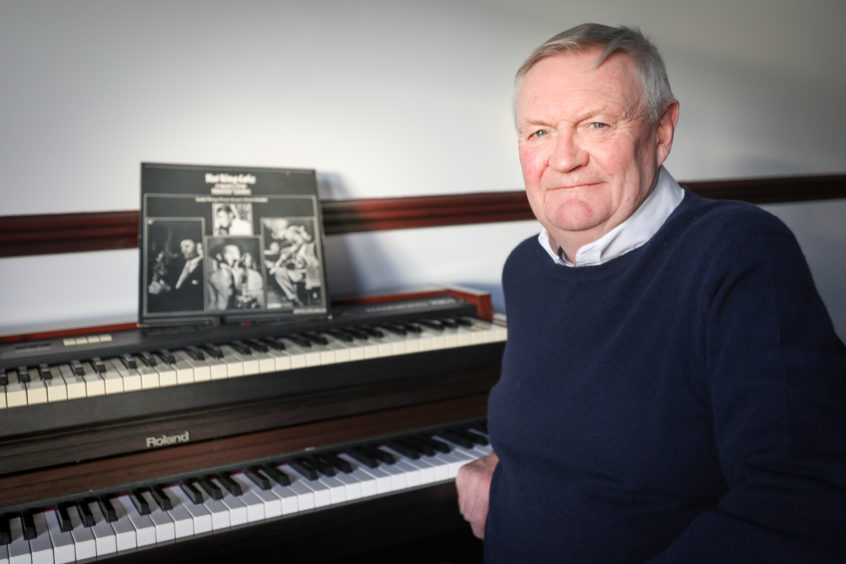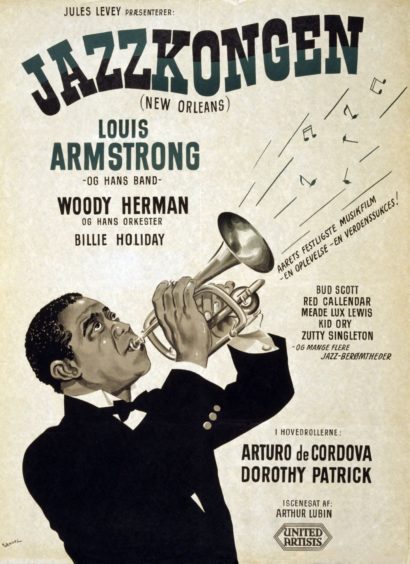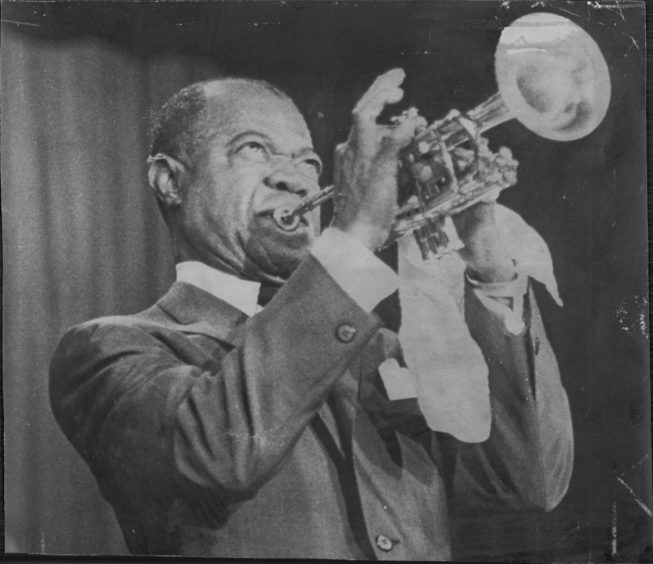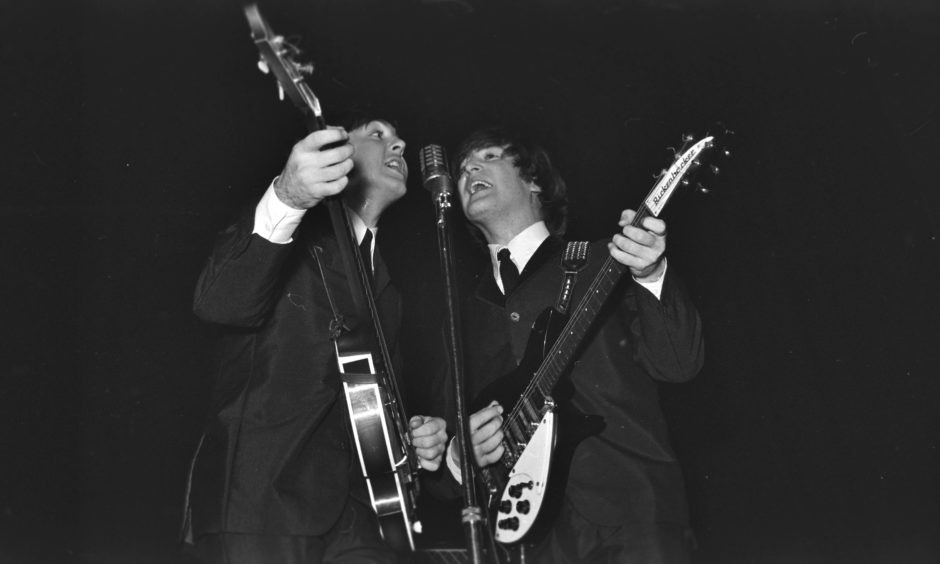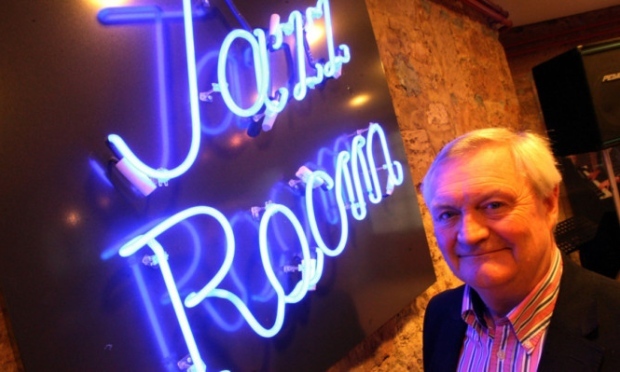Louis Armstrong brought the wonderful world of jazz to Dundee in 1933 after being paid £40 to appear at the Palais dance hall.
Jazz was being heard in Dundee through a number of channels, mainly by listening to records, by listening to the radio and by seeing visiting musicians.
Armstrong’s appearance took things to a new level.
The Picasso of American jazz, who was now known as Satchmo, had started appearing in movies, and was billed as “the world’s greatest trumpet player” when he arrived in Dundee.
He was on a UK tour and performing at the Empire Theatre in Edinburgh when James Duncan, who ran the Tay Street dance hall, contacted Armstrong’s agent Jack Hylton and arranged for him to be brought through one night after a second house.
He played 10 numbers from 10pm with Harry Smead’s resident band before leaving immediately afterwards to return to Edinburgh by car for the following day’s show.
The Courier said he gave “ample evidence of his amazing trumpet technique, unique vocal efforts, and many personal characteristics”.
The review said: “His programme included items which had already been associated with his name by reason of his gramophone recordings.
“He revelled in such numbers as ‘Dinah’, ‘Tiger Rag’, You Rascal You’ and ‘St Louis Blues’.”
The Evening Telegraph’s report on December 2 said: “Louis Armstrong, maestro of the trumpet, gave them notes so blue that they resounded off the roof like animated sapphires.”
Alan Steadman, jazz promoter and broadcaster, said local jazz fans must have felt disbelief when Armstrong turned up in Dundee.
“He had toured the UK the preceding year but it was still very unusual for a musician of his calibre to appear locally: a bit like the Beatles’ first concert at the Caird Hall 30 years later,” he said.
“He had sailed to the UK on the liner ‘Homeric’ at a time when he was having management – and resultant financial – problems.
“The well-known British band leader Jack Hylton took him under his wing and arranged not only a string of UK gigs but also some across Europe too.
“To describe him as the Picasso of Jazz and the world’s greatest trumpet player were not, I think, over-statements.
“He too was a genius as he was the main driver in breaking the mould in which the music had been; and in moving it forward.
“Hitherto it had been regarded as a kind of black folk music with novelty and vaudeville aspects.
“With his ground-breaking recordings of the late 1920s he moved jazz forward into the mainstream of the art form it was to become.
“His technique, phrasing, soloing, unique style of ‘scat’ singing and his ebullient personality were his trademarks and they seem to have been on show on that particular night.
“At that time too he was incorporating pop songs of the day into his repertoire – as well as blues and rags – and he was beginning to move towards being the all-round entertainer he was to become famous for.
“This appearance at the Palais would certainly have been a pivotal moment for local jazz fans.
“He was box-office material and he was playing the type of jazz that was to remain popular in Dundee for many years to come.
“So, yes, it could well have been a seminal moment.
“Taking a leaf from Louis’ book other jazz greats like Duke Ellington and Coleman Hawkins were also to make trips to the UK.”
Armstrong returned to Scotland in 1956 and performed at the Pavilion Theatre in Glasgow where he played on a raised, revolving stage in the middle of the hall’s circus ring.
Satchmo was joined on stage before a half-full audience by a young Scottish-American singer, Ella Logan, who brought him a fish supper after the show which he ate in his dressing room.
As far as Dundee was concerned the place to hear traditional jazz was a club in Parker Street which ran weekly concerts on a Sunday from around 1953-1961.
The club was unlicensed but was usually packed.
The first band to play there was The Pelican Jazz Band which included two Courier journalists, Jack Hutton and Bert Powell.
Then came The East Coast Jazzmen.
Well-known jazz musicians like Kenny Ball, Chris Barber, Alex Welsh and George Melly appeared there as guests.
Sunday Jazz was also a feature at the Sands nightclub on the Esplanade in Broughty Ferry in the late 1970s and early 1980s with a band led by trumpet player Jimmy Deuchar.
Jimmy came from Dundee and was a world-famous exponent of modern jazz having played with Johnny Dankworth and Ronnie Scott.
The epicentre of Scottish jazz however was undoubtedly Edinburgh although the west coast did have one of the best bands in the Clyde Valley Stompers.
At one point in the early 1980s Edinburgh had an incredible 49 venues putting on live jazz every week.
Annual festivals in Edinburgh, Glasgow, Dundee and Aberdeen have also been instrumental in bringing jazz acts from all over the world.
Kenny Ball and his Jazzmen performed at Dundee Jazz Festival in 1997 where they performed such classics as Black and Tan Fantasy, Blue Turning Grey, and Chimes Blues.
Mr Steadman kept the jazz tradition alive in the city in the 1980s and 90s after starting a weekly radio show in 1983 which became the longest-running in the UK and went on for 33 years.
He also runs Jazz at Hospitalfield in Arbroath which started in 1990 and has featured bands and vocalists from all over Britain plus internationally-acclaimed artists.
Mr Steadman said: “Growing up in the 1960s I was of course into the Beatles and Stones etc but I was also a jazz fan from my early teens.
“I was given a present of an LP of the Glenn Miller Story which I loved especially the tracks featuring Louis Armstrong.
“The early 1960s was the age of trad jazz and I loved the bands led by Kenny Ball, Acker Bilk, Humphrey Lyttelton and Chris Barber.
“The latter also introduced me to the blues.
“The first ever concert I attended was by Kenny Ball and his Jazzmen at the Caird Hall in Dundee around 1962.
“Many years later Kenny told me that he remembered that concert well too as the band’s van had a puncture at Invergowrie.
“It ran off the road but no one was injured.
“Through entering jazz through the traditional door I then went on to discover all the other genres of the music.
“I got into local radio through hospital radio.
“I was doing a jazz show on Mayfield Radio in Edinburgh when I got the call from Radio Tay.
“I don’t think it was a gamble at the time although I don’t think many of the other local stations were covering jazz.
“Radio Tay, in these days, was a proper local station and its music policy included folk, country and Scottish; so why not jazz too?
“I think the gamble may have come as time went on and the station changed direction and listening figures became all important.
“But I had a loyal audience and managed to stay at Tay for 30 years followed by another three years at Wave 102.
“I’m pretty sure it was the UK’s longest running jazz show – given that it was on air continuously with the same presenter throughout.
“That would be the highlight but there were many other high spots.
“I managed to get interviews with many great musicians including two who were well known for not engaging with the media – Leon Redbone and Mose Allison.
“I am also proud of the fact that I may well have turned on quite a few folk to jazz through my programmes.”
A true musical legend from The Battlefield
Armstrong was born in Louisiana in 1901, the son of a factory worker, in a neighbourhood so poor it was nicknamed ‘The Battlefield’.
After leaving the orphanage at the age of 15, he worked odd jobs while playing in bars at night.
One of the greatest cornet players in town, Joe “King” Oliver, took young Armstrong under his wing, and his musical reputation began to grow.
His first recording session took place in Richmond, Indiana, a place with big Ku Klux Klan links, and he later had to travel far and wide for work during the Great Depression.
None of it stopped him becoming a true musical legend.
He is best known for songs like What a Wonderful World, Hello, Dolly, Star Dust and La Vie En Rose.
Armstrong’s voice has also been heard in space.
In 1998 John Glenn woke for his first full day back in space to the gravelly voice of Armstrong singing What A Wonderful World.
Glenn and his six crew-mates awoke at 8.45am with Armstrong singing about “skies of blue, clouds of white”.
“Good morning, Discovery,” Mission Control called up.
“Welcome to a second day in space.”
Alan Steadman marks 100 years since the first blues recording was made
Blues has always been at the bedrock of jazz.
No one knows when the first blues tune was played.
Blues most likely developed through group authorship in the Mississippi Delta drawing on folk songs, work songs, spirituals and street cries.
What we do know is when the first blues recording was made; 100 years ago on the 10th of August.
Mamie Smith, a black vaudeville artist, had recorded a couple of popular songs for the Okeh record label in February 1920.
The record had sold reasonably well, enough for the company to recall her for another session.
Along with her band called the Jazz Hounds she recorded Crazy Blues and the trigger was pulled.
The song which also had other titles wasn’t really an out-and–out blues track.
It also had elements of popular song and ragtime as it had originally been written for a stage show. The mechanical recording technique of that time was still very basic.
Vocals were made into a large horn and the frequency of the female voice was apparently captured better than its male counterpart.
Sales of Crazy Blues were enormous; it sold 75000 copies a week and ended up being a million seller.
The craze of “race records” had begun.
The significance of this first blues record cannot be over-stated. It led to a proliferation of recordings from several other female singers, the best known being Bessie Smith.
Delta bluesmen like Blind Lemon Jefferson and Robert Johnson were to follow and then, after the music had moved to the city, came household names like Muddy Waters and BB King.
The importance of the blues in the development of popular music is also immense. Its simple make-up of 12 bars and three chords has become one of the most enduring and influential musical formats of the 20th century.
When asked if jazz should always have the blues in it, trumpet virtuoso Wynton Marsalis replied “If it’s any good, it does!”
The post–war craze of rhythm and blues was up-tempo music to dance to.
This was the precursor of a phenomenon that was to change the direction of popular music – rock’n’roll.
Elvis Presley’s first hit, “That’s All right Mama” was a blues song written by Arthur “Big Boy” Crudup.
In 1950’s Britain, the “skiffle” craze drew heavily on country blues. Lonnie Donegan, the King of Skiffle, had a Top 10 hit with Rock Island Line, a song associated with another blues legend, Leadbelly.
Blues music reached its peak in the UK in the early 1960s.
Groups like The Animals. The Yardbirds and Fleetwood Mac were all blues bands.
The Rolling Stones took its name from a Muddy Waters number and their version of Little Red Rooster was one from the Howlin’ Wolf songbook.
Little Red Rooster is the only 12 bar blues to reach No 1 in the charts.
The Beatles were heavily influenced by skiffle and artists like Eric Clapton, Van Morrison and David Bowie all started off playing and singing the blues.
Soul music and present day R&B are also direct descendants of this music.
Although its popularity has waned somewhat, blues music is still being performed today. All jazz musicians have blues in their repertoire; it’s the common denominator when they come together to play for the first time.
Present day artists like Eric Bibb and Keb Mo, whilst maintaining a link with the old Delta bluesman, play in a post-modern style.
Locally, the jazz educator and broadcaster Richard Michael has developed a model to introduce blues to both members of the Fife Youth Jazz Orchestra and his students at St Andrews University.
He says ‘it’s the most accessible way into understanding jazz. You can sound good with just a few notes… but it’s where you put them that counts’.
Dundee born jazz singer Ali Affleck regards the first blues recording as a turning point whereby the leading ladies of early blues first began to get noticed. She has for a long time been inspired by Mamie Smith and is currently involved in stage shows keeping the flame alive.
So Mamie Smith could have had no idea what she was starting off when she made her seminal recording on the 10th of August 1920.
Happy 100th anniversary to the blues!
